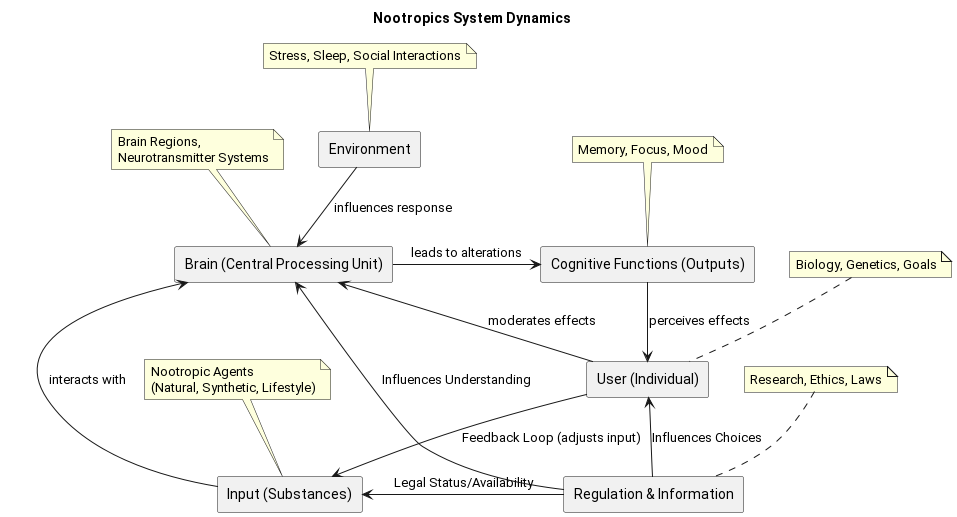Nootropics
Table of Contents
1. Systems Breakdown
1. Key Components of the Nootropics System:
- Input (Substances): These are the nootropic agents themselves, which can range from natural compounds (e.g., L-Theanine, Caffeine, Bacopa Monnieri) to synthetic drugs (e.g., Piracetam, Modafinil). They can also include lifestyle factors like diet and exercise.
- User (Individual): The person consuming or utilizing the nootropic substance or strategy. This includes their unique biology, genetics, pre-existing cognitive state, and goals.
- Brain (Central Processing Unit): The primary target of nootropics. This includes various brain regions,Neurotransmitters systems (e.g., dopamine, acetylcholine, GABA), and neural pathways.
- Cognitive Functions (Outputs): The desired outcomes or effects of nootropics, such as improved memory, focus, attention, mood, creativity, and overall cognitive performance.
- Environment: The context in which the nootropic is used. This includes factors like stress levels, sleep quality, social interactions, and task demands.
- Feedback Loops: The user's subjective experience and objective measurements (if available) of the nootropic's effects. This feedback informs future decisions about dosage, frequency, and choice of nootropic.
- Regulation & Information (Context): Legal status, availability, scientific research, anecdotal reports, and ethical considerations surrounding nootropics.
2. Analysis of Relationships and Interactions:
- Input -> Brain: Nootropic substances interact with the brain through various mechanisms. Some may directly affect neurotransmitter levels, while others may influence blood flow, neural plasticity, or protect against oxidative stress.
- Brain -> Cognitive Functions: Changes in brain activity (induced by nootropics) lead to alterations in cognitive functions. The specific cognitive effects depend on the nootropic, the individual, and the task at hand.
- User -> Brain: The user's individual biology (genetics, age, health status) moderates the effects of nootropics on the brain. What works for one person may not work for another.
- Environment -> Brain: Environmental factors (stress, sleep, etc.) can influence the brain's response to nootropics. A stressed individual may experience different effects than a relaxed one.
- Cognitive Functions -> User: The user perceives the effects of nootropics on their cognitive functions. This subjective experience drives the feedback loop.
- Feedback -> Input: Based on the perceived effects (or lack thereof), the user adjusts the input (e.g., changes dosage, switches to a different nootropic, or stops using nootropics altogether).
- Regulation & Information -> All Components: This influences the user's choices, the availability of substances, and the understanding of potential risks and benefits.
3. Breakdown into Simpler Parts:
To understand the system better, we can focus on specific aspects:
- Neurotransmitter Pathways: Analyze how specific nootropics affect particular neurotransmitter systems (e.g., how choline sources influence acetylcholine production and its impact on memory).
- Cognitive Domains: Focus on how nootropics impact specific cognitive functions (e.g., examining the effect of stimulants on attention and focus).
- Individual Variability: Investigate the factors that contribute to differences in responses to nootropics (e.g., how genetics influence caffeine sensitivity).
- Ethical Implications: Debate the moral considerations of using nootropics for cognitive enhancement.
4. Visual/Conceptual Model:
@startuml title Nootropics System Dynamics rectangle "Input (Substances)" as Input rectangle "User (Individual)" as User rectangle "Brain (Central Processing Unit)" as Brain rectangle "Cognitive Functions (Outputs)" as Cognitive rectangle "Environment" as Environment rectangle "Regulation & Information" as Context Input -right-> Brain : interacts with User -up-> Brain : moderates effects Environment -down-> Brain : influences response Brain -right-> Cognitive : leads to alterations Cognitive -right-> User : perceives effects User -down-> Input : Feedback Loop (adjusts input) Context -left-> Input : Legal Status/Availability Context -left-> User : Influences Choices Context -left-> Brain : Influences Understanding note top of Input : Nootropic Agents\n(Natural, Synthetic, Lifestyle) note top of User : Biology, Genetics, Goals note top of Brain : Brain Regions,\nNeurotransmitter Systems note top of Cognitive : Memory, Focus, Mood note top of Environment : Stress, Sleep, Social Interactions note top of Context : Research, Ethics, Laws @enduml

5. Actionable Insights and Recommendations:
- Personalized Approach: Recognize that nootropics are not a one-size-fits-all solution. Experimentation and careful self-monitoring are crucial to finding what works best for an individual.
- Prioritize Foundational Health: Nootropics are likely to be more effective when combined with a healthy lifestyle (adequate sleep, balanced diet, regular exercise, and stress management).
- Start Low and Go Slow: Begin with low doses of any new nootropic and gradually increase the dosage while carefully monitoring for side effects.
- Focus on Stacking Strategically: Combine nootropics with complementary mechanisms of action. For example, pair a stimulant (like caffeine) with a calming agent (like L-Theanine) to reduce anxiety.
- Consider Cycling: Avoid building tolerance or dependence by cycling on and off certain nootropics.
- Stay Informed and Critical: Evaluate information about nootropics from reputable sources and be wary of exaggerated claims.
- Consult Professionals: Seek advice from a healthcare professional before using nootropics, especially if you have any underlying health conditions or are taking other medications.
- Ethical Use: Reflect on the ethical implications of cognitive enhancement and use nootropics responsibly.
By understanding the nootropics system in its entirety, individuals can make more informed decisions about their cognitive enhancement strategies and maximize their potential benefits while minimizing risks.